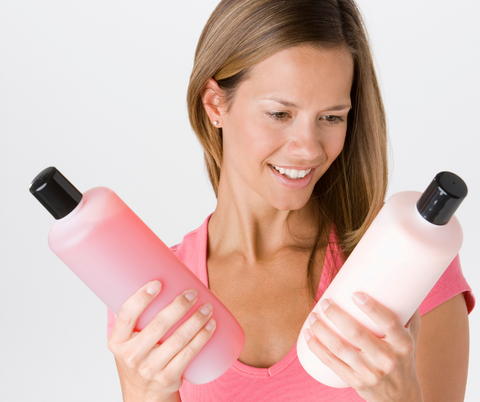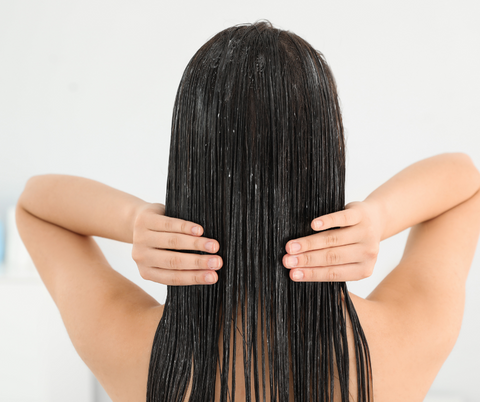Beauty lovers have long debated over the best way to start a hair care routine: should one use conditioner or shampoo first? To achieve healthy, luscious locks, it is vital to comprehend the significance of this choice. Let us investigate the intricacies of this debate and examine the advantages of each strategy.

Understanding the Debate
When it comes to hair care, the sequence in which you apply shampoo and conditioner can have a big influence on how your wash regimen turns out. There has been disagreement over this issue for many years, with supporters of both conditioning and shampooing first. Let's examine each viewpoint in more detail to determine the reasoning behind these divergent strategies.
The Case for Shampoo First
Benefits of Shampooing First
Many people choose to use shampoo as the first step in their hair-cleaning routine, citing a number of advantages. Cleaning the scalp thoroughly with shampoo first enables efficient removal of extra oil, debris, and product buildup. Your hair is more able to absorb the nourishing effects of conditioner when it is starting from scratch, which leads to softer, more manageable locks.
Step-by-Step Guide to Shampooing First
To fully benefit from shampooing first, moisten your hair completely with warm water. Using gentle circular motions, apply a tiny amount of shampoo to your palms and lather it into your scalp. Focusing on regions prone to oiliness or buildup, work the shampoo through the lengths of your hair. Before using conditioner, make sure all traces of shampoo are gone by giving the hair a thorough rinse in lukewarm water.

The Argument for Conditioner First
Advantages of Conditioning First
Some people, however, argue that conditioner should be applied before shampooing. This method, dubbed "pre-pooing," entails conditioning the hair to create a shield against shampoo's possible drying effects. You can prevent damage and assist keep moisture by applying conditioner to the hair strands before washing. This will leave your hair feeling softer and more hydrated after washing.
Step-by-Step Guide to Conditioning First
The first step in adding conditioning to your hair care routine is to wet your hair with warm water. From the mid-length to the ends, generously apply conditioner, paying special attention to regions that are prone to damage or dryness. To disperse the conditioner evenly and untangle any snarls or knots, use a wide-tooth comb. After a few minutes, let the conditioner work its way down the hair shaft and then give it a thorough water rinse.

Hair Care Tips from Professionals
We consulted hairstylists and other specialists in the field to get their professional advice on the best hair care routine. They provide the following helpful advice and suggestions to help you have healthy, gorgeous hair:
Know Your Hair Type: Knowing what type of hair you have is essential for choosing the correct products and creating a routine that works for you. Regardless of whether your hair is coily, wavy, curly, or straight, customize your routine to meet its specific requirements.
Use Quality Products: Invest in premium shampoo and conditioner that are made with healthy components that are appropriate for the type of hair you have. Sulfates and parabens, two abrasive chemicals that can deplete hair of its natural oils and cause damage and dryness, should be avoided in hair care products.
Follow Proper Washing Techniques: In order to remove buildup and pollutants from your scalp, concentrate on rubbing the shampoo into your hair. To avoid weighing down the hair, apply the conditioning product from the mid-length to the ends, avoiding the scalp.
Don't Overwash: Although maintaining clean hair is crucial, frequent washing can deplete the hair's natural oils, causing it to become dry and brittle. Try to wash your hair no more than twice or thrice a week, or more often if necessary given your lifestyle and degree of exercise.
Protect Your Hair: Wear protective hairstyles like braids or buns and use heat protectant sprays to shield your hair from heat styling tools and environmental stressors. Moreover, spend money on satin or silk pillows to reduce rubbing and stop damage while you sleep.
Regular Trims: Plan on getting your hair trimmed every 6 to 8 weeks to avoid split ends and to keep your hair looking healthy and full. Cutting off damaged ends encourages healthy development and improves the appearance and feel of your hair.
Hydrate from Within: Drink lots of water to stay hydrated, and eat a well-balanced diet full of vitamins, minerals, and important fatty acids. Foods high in nutrients, such as fruits, vegetables, and lean meats, promote good hair development and general well-being.
You may have thick, beautiful hair that exudes energy and health by implementing these professional hair care methods. To achieve the best results, always pay attention to your hair's needs and modify your regimen as needed. You may have gorgeous, manageable hair that accentuates your inherent beauty if you give it the right care and attention.

FAQ’s
Should I shampoo or condition my hair first?
The order in which you shampoo and condition your hair depends on personal preference and hair type. Shampooing first cleanses the scalp and removes impurities, while conditioning first can provide a protective barrier against shampoo-induced dryness.
What are the benefits of shampooing first?
Shampooing first allows for a thorough cleansing of the scalp, removing excess oil, debris, and product buildup. Starting with clean hair enables better absorption of the nourishing effects of conditioner, resulting in softer, more manageable locks.
Why would someone condition their hair before shampooing?
Conditioning hair before shampooing, known as "pre-pooing," creates a shield against shampoo's potential drying effects. This helps prevent damage and retains moisture, leaving hair softer and more hydrated after washing.
How often should I wash my hair?
It's essential to strike a balance between cleanliness and maintaining the natural oils in your hair. Aim to wash your hair no more than 2-3 times a week, adjusting based on your lifestyle and activity level.
What are some hair care tips from professionals?
Professionals recommend knowing your hair type, using quality products free from harsh chemicals, following proper washing techniques, avoiding overwashing, protecting your hair from heat and environmental stressors, scheduling regular trims, and maintaining hydration through a balanced diet and plenty of water intake.

The high-quality natural hair care products from REV-320 will elevate your hair care routine. Whether you're arguing over which shampoo and conditioner to use first or looking for professional advice for tangle-free, healthier hair, our products are made to last. We provide an extensive array of hair care options, ranging from conditioning and cleaning to nourishing and styling. Don't put off getting the hair of your dreams any longer—get in touch with us or place an online order right now to witness nature's transformational power for yourself.


